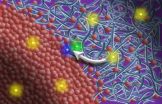(Press-News.org) (Edmonton) Overweight children are far more likely to take prescription medications than children of a normal weight—a trend that adds to already higher health-care costs for treating childhood obesity, according to new research from the University of Alberta.
Researchers from the School of Public Health analyzed the medication use of more than 2,000 Canadian children through the 2007 to 2009 Canadian Health Measures Survey. They found that overweight and obese kids aged 12 to 19 years were 59 per cent more likely than their normal-weight peers to take prescription medication.
Co-author Christina Fung said prescription drug expenditures have doubled over the past decade and now account for 17 per cent of health-care costs in Canada—the second highest after hospital expenses. Having a more complete picture helps governments and health-care providers direct spending more effectively, she said.
"Overweight and obese patients are more expensive to the health-care system in terms of using medication and prescription drugs," she said. "In Canada, we have a public health-care system, and this is an issue of accountability and where health-care dollars are spent, and when."
The study also showed that overweight and obese children were twice as likely to take medication for respiratory ailments such as asthma and allergies.
Co-author Paul Veugelers, Canada Research Chair in Population Health, said the data show that governments need to direct more attention to prevention. Childhood obesity rates have tripled in Canada over the last 25 years, and an estimated 34 per cent of kids aged two to 17 are now overweight or obese.
"By investing in prevention in kids—promotion of healthy eating and active living—there's an immediate payback in terms of health-care costs," said Veugelers, a professor and director of the Population Health Intervention Research Unit that works with the Alberta Project Promoting active Living and healthy Eating (APPLE Schools).
"Children who are not overweight are less likely to develop diabetes, or 30 to 40 years later get a heart attack or end up with cancer. Forty years from now you see a real return in terms of health-care costs."
The results showed little difference in medication use among children aged six to 11. Veugelers hypothesized that this finding could indicate that a prolonged lifestyle of unhealthy eating and physical inactivity is needed before children need additional medication.
###
The research was published in the September issue of Archives of Disease in Childhood and was funded by the Canada Research Chair in Population Health and Alberta Innovates – Health Solutions Health Scholarship.
Medication use higher among overweight, obese kids
Overweight children aged 12 to 19 are 59% more likely than normal-weight kids to take prescription medication, according to UAlberta research
2012-10-05
ELSE PRESS RELEASES FROM THIS DATE:
TMT will take discoveries of stars orbiting the Milky Way's monster black hole to the next level
2012-10-05
Researchers have discovered a star that whips around the giant black hole at the center of our galaxy in record time, completing an orbit every 11.5 years. The finding, appearing today in the journal Science, points ahead to groundbreaking experiments involving Einstein's general theory of relativity. Those tests will be fully enabled by the Thirty Meter Telescope (TMT), slated to begin observations next decade.
The record-setting star, called S0-102, was detected with the twin 10-meter telescopes at the W.M. Keck Observatory in Hawaii. For the past 17 years, the telescopes ...
Story tips from the Department of Energy's Oak Ridge National Laboratory, October 2012
2012-10-05
ELECTRICITY-- Spotlight on outages . . .
When a storm knocks out power, among the first questions to be answered are how many people are affected and when electricity will be restored. Oak Ridge National Laboratory's Energy Awareness and Resiliency Standardized Services application, or EARSS, uses publicly available data and can help by showing grid status in real time. The goal is to enhance situational awareness for the emergency response community, according to EARSS co-developer Steve Fernandez of ORNL's Computational Sciences and Engineering Division. "Working from ...
Researchers find ancient carbon resurfacing in lakes
2012-10-05
RICHMOND, Va. (Oct. 4, 2012) – A new study reveals that a significant amount of carbon released into the atmosphere from lakes and rivers in Southern Québec, Canada, is very old – approximately 1,000 to 3,000 years old – challenging the current models of long-term carbon storage in lakes and rivers.
Previous studies have suggested that there is a tight coupling between the terrestrial and aquatic environment such that aquatic bacteria rapidly consume modern carbon. The new findings of the respiration of old carbon in aquatic systems suggests there may be significant lags ...
Northern conifers youngest of the species
2012-10-05
New Haven, Conn.—Dramatic shifts in the planet's climate and geography over millions of years changed the course of evolutionary history for conifer trees, according to a Yale paper in the Proceedings of the National Academy of Sciences.
Yale researchers examined the fossil record and genetic makeup of 489 out of more than 600 living conifer species and discovered that while most conifers belong to ancient lineages, most Northern Hemisphere species, including the majority of pines and spruces, appeared within the past 5 million years.
They argue that the migration ...
Researchers reveal how solvent mixtures affect organic solar cell structure
2012-10-05
Controlling "mixing" between acceptor and donor layers, or domains, in polymer-based solar cells could increase their efficiency, according to a team of researchers that included physicists from North Carolina State University. Their findings shed light on the inner workings of these solar cells, and could lead to further improvements in efficiency.
Polymer-based solar cells consist of two domains, known as the acceptor and the donor layers. Excitons, the energy particles created by solar cells, must be able to travel quickly to the interface of the donor and acceptor ...
Improving confidence keeps breast cancer survivors exercising
2012-10-05
CORVALLIS, Ore. – More than 40 percent of older breast cancer survivors are insufficiently active after leaving a supervised program. But new research shows that those women who developed behavioral skills such as self-confidence and motivation during their program were far more likely to continue exercising on their own.
Regular exercise may reduce the risk of breast cancer recurrence and breast cancer-related mortality, experts say, making it crucial to effectively target breast cancer survivors who do not engage in regular physical activity for interventions.
Researchers ...
Why we need insects -- even 'pesky' ones
2012-10-05
At first blush, many people would probably love to get rid of insects, such as pesky mosquitoes, ants and roaches. But a new study indicates that getting rid of insects could trigger some unwelcome ecological consequences, such as the rapid loss of desired traits in plants, including their good taste and high yields.
Specifically, the study--described in the Oct. 5, 2012 issue of Science and funded by the National Science Foundation showed that evening primroses grown in insecticide-treated plots quickly lost, through evolution, defensive traits that helped protect them ...
MU researcher identifies factors to help parents and professionals recognize teens in distress
2012-10-05
Suicide is the third-leading cause of death for teens, according to the Centers for Disease Control and Prevention. Now, a University of Missouri public health expert has identified factors that will help parents, medical professionals and educators recognize teens at risk for self injury and suicide.
"For many young people, suicide represents an escape from unbearable situations—problems that seem impossible to solve or negative emotions that feel overwhelming," said Lindsay Taliaferro, an assistant professor of health sciences at MU. "Adults can help these teens dissect ...
Sandia Labs benchmark helps wind industry measure success
2012-10-05
ALBUQUERQUE, N.M. – Sandia National Laboratories published the second annual 2012 Wind Plant Reliability Benchmark on Monday, and the results should help the nation's growing wind industry benchmark its performance, understand vulnerabilities and enhance productivity.
Until now, wind farm owners and operators had no way to compare their output with the output of similar operations. To benchmark the reliability of the U.S. wind turbine fleet and identify major causes of failures and downtime, the DOE commissioned Sandia in 2010 to build the Continuous Reliability Enhancement ...
Far, far beyond wrist radios
2012-10-05
To believe that technologies once dreamed of in science fiction novels, television shows, and comic strips may one day be a reality, or that real-world technologies might make the fantastic devices of fiction obsolete, you'd need to be either an optimist…or a futurist in the Department of Homeland Security (DHS)'s Science and Technology Directorate (S&T).
To keep dreams grounded, S&T maintains a team of futurists in Arlington, Va., at the Homeland Security Studies & Analysis Institute (HSSAI). There, in the Resilience and Emergency Preparedness / Response Branch, analysts ...
LAST 30 PRESS RELEASES:
Making lighter work of calculating fluid and heat flow
Normalizing blood sugar can halve heart attack risk
Lowering blood sugar cuts heart attack risk in people with prediabetes
Study links genetic variants to risk of blinding eye disease in premature infants
Non-opioid ‘pain sponge’ therapy halts cartilage degeneration and relieves chronic pain
AI can pick up cultural values by mimicking how kids learn
China’s ecological redlines offer fast track to 30 x 30 global conservation goal
Invisible indoor threats: emerging household contaminants and their growing risks to human health
Adding antibody treatment to chemo boosts outcomes for children with rare cancer
Germline pathogenic variants among women without a history of breast cancer
Tanning beds triple melanoma risk, potentially causing broad DNA damage
Unique bond identified as key to viral infection speed
Indoor tanning makes youthful skin much older on a genetic level
Mouse model sheds new light on the causes and potential solutions to human GI problems linked to muscular dystrophy
The Journal of Nuclear Medicine ahead-of-print tip sheet: December 12, 2025
Smarter tools for peering into the microscopic world
Applications open for funding to conduct research in the Kinsey Institute archives
Global measure underestimates the severity of food insecurity
Child survivors of critical illness are missing out on timely follow up care
Risk-based vs annual breast cancer screening / the WISDOM randomized clinical trial
University of Toronto launches Electric Vehicle Innovation Ontario to accelerate advanced EV technologies and build Canada’s innovation advantage
Early relapse predicts poor outcomes in aggressive blood cancer
American College of Lifestyle Medicine applauds two CMS models aligned with lifestyle medicine practice and reimbursement
Clinical trial finds cannabis use not a barrier to quitting nicotine vaping
Supplemental nutrition assistance program policies and food insecurity
Switching immune cells to “night mode” could limit damage after a heart attack, study suggests
URI-based Global RIghts Project report spotlights continued troubling trends in worldwide inhumane treatment
Neutrophils are less aggressive at night, explaining why nighttime heart attacks cause less damage than daytime events
Menopausal hormone therapy may not pose breast cancer risk for women with BRCA mutations
Mobile health tool may improve quality of life for adolescent and young adult breast cancer survivors
[Press-News.org] Medication use higher among overweight, obese kidsOverweight children aged 12 to 19 are 59% more likely than normal-weight kids to take prescription medication, according to UAlberta research





